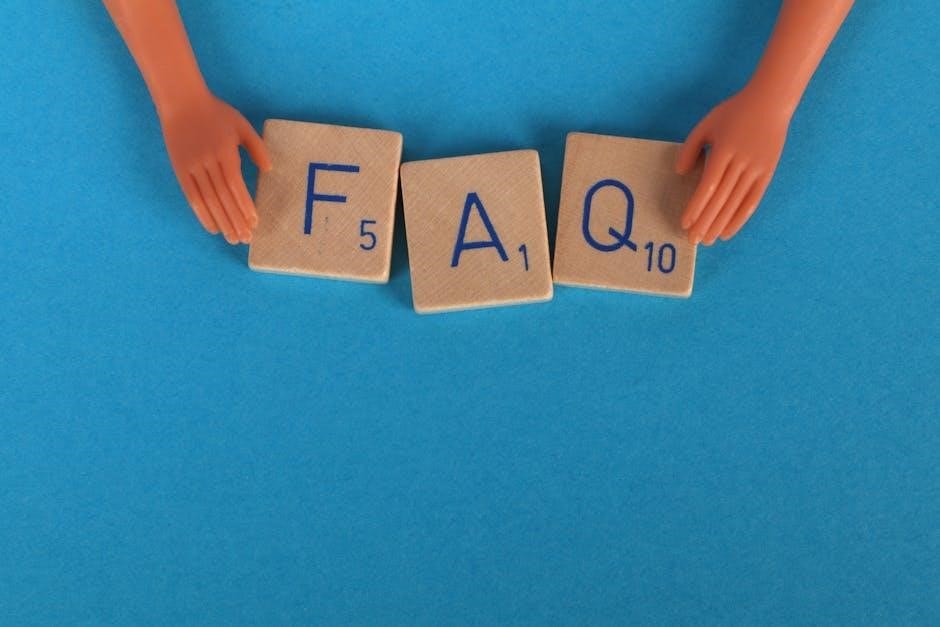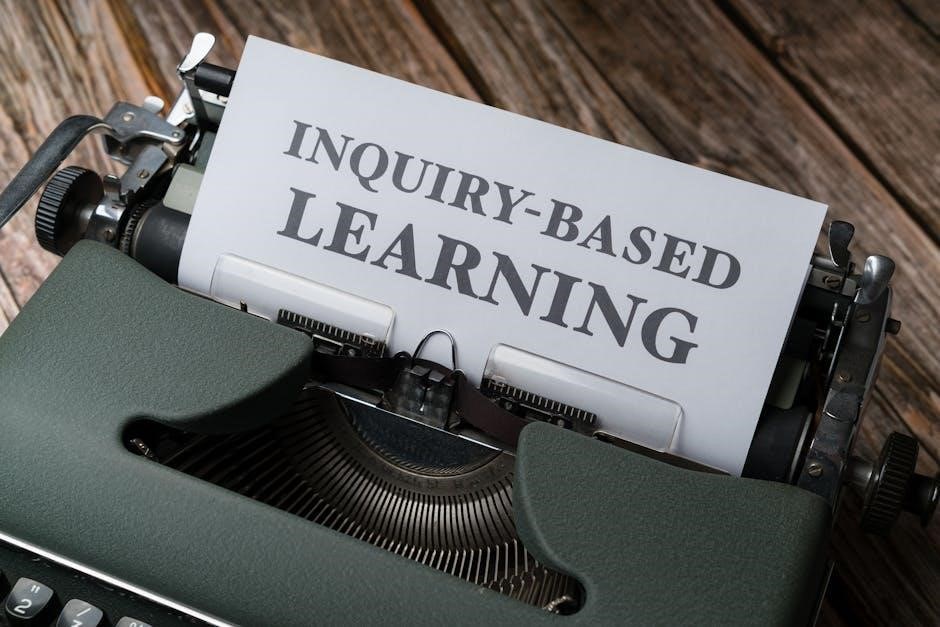Fraction word problems are a fundamental aspect of mathematics‚ often presenting complexity in real-world scenarios. A PDF guide offers comprehensive solutions‚ enhancing problem-solving strategies and understanding.
1.1 Overview of Fraction Word Problems
Fraction word problems involve applying fraction operations to real-world scenarios. They often require identifying parts of a whole‚ comparing quantities‚ or solving for unknowns. These problems can involve addition‚ subtraction‚ multiplication‚ or division of fractions‚ making them versatile for assessing mathematical understanding. Many resources‚ such as PDF guides‚ provide step-by-step solutions to common fraction word problems‚ helping students grasp key concepts. These problems are essential for developing critical thinking and problem-solving skills‚ as they require translating words into mathematical expressions. By practicing with diverse examples‚ learners can build confidence in handling fractions and applying them to practical situations effectively.
1.2 Importance of Solving Fraction Word Problems
Solving fraction word problems is crucial for developing foundational math skills and logical reasoning. These problems enhance understanding of part-whole relationships‚ ratios‚ and proportions‚ which are essential in real-world applications like cooking‚ construction‚ and finance. Mastering fraction word problems fosters critical thinking‚ as they often require translating words into mathematical operations. This skill improves problem-solving abilities and prepares students for advanced math concepts. Additionally‚ practice with fraction word problems builds confidence and fluency in handling numerical relationships. Resources like PDF guides provide structured examples and solutions‚ making it easier for learners to grasp and apply these concepts effectively in various scenarios.

Types of Fraction Word Problems
Fraction word problems include multiplication‚ division‚ addition‚ and subtraction scenarios. They often involve real-world applications‚ such as cooking‚ construction‚ and finance‚ requiring practical problem-solving skills.
2.1 Multiplication and Division of Fractions
Multiplication and division of fractions are essential skills for solving word problems. These operations often involve real-world scenarios‚ such as calculating speed‚ distance‚ and time. For example‚ dividing a recipe requires understanding how to adjust ingredient quantities using fraction division. Multiplication of fractions is common in scaling recipes or calculating areas. Word problems may involve comparing rates or proportions‚ which require precise fraction operations. Common mistakes include forgetting to convert improper fractions to mixed numbers or misidentifying the whole in a problem. Practicing with resources like PDF guides can help master these concepts and improve problem-solving confidence. Regular practice is key to fluency in fraction operations.
2.2 Addition and Subtraction of Fractions
Addition and subtraction of fractions are fundamental skills for solving word problems. These operations often involve finding a common denominator‚ which is crucial for accurate calculations. For instance‚ word problems might ask for the total time spent on tasks or the combined length of materials. A common challenge is ensuring the denominators are the same before performing the operation. Misconceptions‚ such as incorrectly identifying the whole or miscalculating the least common denominator‚ can lead to errors. Practicing with PDF guides and real-world examples helps build proficiency. Regular practice and feedback are essential for mastering these operations and applying them confidently to word problems.
2.3 Real-World Applications of Fraction Word Problems
Fraction word problems have numerous real-world applications‚ making them essential for practical skills. Scenarios like cooking‚ construction‚ and finance often involve fractions. For example‚ adjusting recipes or calculating material costs. PDF guides provide problems that mirror these situations‚ helping students connect math to daily life. These applications highlight the importance of accurate calculations and understanding fraction operations. Solving such problems builds critical thinking and problem-solving abilities. Regular practice with relevant examples ensures readiness for real-life challenges‚ making fraction word problems a vital part of mathematical education and practical proficiency. These applications emphasize the value of fractions in everyday tasks and professional settings.

Strategies for Solving Fraction Word Problems
Effective strategies include identifying key information‚ using visual aids‚ and breaking problems into simpler steps. These approaches enhance understanding and improve problem-solving skills significantly.
3.1 Understanding the Problem and Identifying Key Information
Understanding the problem is the first step in solving fraction word problems. Identify what is being asked and determine the known and unknown quantities. This involves reading the problem carefully and highlighting key terms. Recognizing the operation needed (addition‚ subtraction‚ multiplication‚ or division) is crucial. Visualizing the problem can help in setting up the correct equation. Breaking down complex scenarios into simpler parts ensures clarity. PDF guides often provide examples that illustrate how to extract relevant information‚ making it easier to apply these strategies effectively. Accurate identification of these elements is essential for forming the correct approach to the solution.
3;2 Using Visual Aids like Diagrams and Models
Visual aids are powerful tools for solving fraction word problems. Diagrams and models help students visualize fractions‚ making abstract concepts more concrete. Pie charts‚ number lines‚ and fraction bars are common visual aids that simplify understanding. These tools are especially helpful for operations like adding or subtracting fractions‚ as they illustrate the parts of a whole. By breaking problems into visual components‚ students can better identify wholes‚ parts‚ and their relationships. PDF guides often include diagrams to demonstrate problem-solving steps‚ reducing confusion and enhancing accuracy. Visual methods also aid in comparing fractions and understanding equivalent values‚ making them indispensable for mastering fraction word problems.
3.3 Breaking Down Complex Problems into Simpler Steps
Breaking down complex problems into simpler steps is a highly effective strategy for solving fraction word problems. By identifying key components and tackling each part separately‚ students can manage intricate scenarios more effectively. PDF guides often provide structured approaches‚ guiding learners through initial problem understanding‚ identifying operations needed‚ and executing calculations step-by-step. This method reduces overwhelm and ensures each part of the problem is addressed accurately. Simplifying problems also helps in identifying common misconceptions‚ such as incorrect identification of wholes or improper fraction conversions. Step-by-step breakdowns enhance clarity and build confidence‚ making even the most challenging problems approachable and solvable. This systematic approach fosters deeper understanding and improves problem-solving skills significantly.

Common Mistakes and Misconceptions
- Forgetting to convert improper fractions to mixed numbers.
- Misidentifying the whole in word problems.
- Miscalculating the least common denominator (LCD).

4.1 Forgetting to Convert Improper Fractions to Mixed Numbers
One common mistake is neglecting to convert improper fractions to mixed numbers. This oversight often occurs when students are comfortable working with improper fractions but fail to recognize the need for mixed numbers in certain contexts. For instance‚ in word problems involving measurements or divisions of whole objects‚ mixed numbers provide clearer‚ more intuitive results. For example‚ 5/4 is more meaningfully expressed as 1 1/4 in scenarios like baking or construction. This error can lead to confusion and incorrect interpretations of answers. To avoid this‚ always assess whether the context requires a whole number representation‚ ensuring clarity and accuracy in solutions.

4.2 Incorrectly Identifying the Whole in Word Problems
A frequent error in fraction word problems is misidentifying the “whole.” This occurs when students fail to correctly interpret what constitutes the entire unit in the context of the problem. For example‚ if a recipe requires 3/4 of a cup of flour for 4 people‚ the whole must be clearly defined as the amount needed for one person or the total quantity. Mislabeling the whole can lead to incorrect calculations and misleading answers. To avoid this‚ it’s crucial to carefully analyze the problem‚ underline key terms‚ and visualize the scenario. Using diagrams or models can also help in accurately identifying the whole and ensuring precise solutions.
4.3 Miscalculating the Least Common Denominator
Miscalculating the least common denominator (LCD) is a common mistake in fraction word problems. The LCD is essential for adding or subtracting fractions with different denominators. Errors often occur when students rush to find the LCD without listing multiples or using prime factorization. For instance‚ confusing the least common multiple with the greatest common divisor can lead to incorrect denominators. This mistake can result in wrong answers‚ especially in complex word problems involving rates or proportions. To avoid this‚ students should systematically list multiples or break down numbers into their prime factors. Double-checking calculations ensures accuracy and builds confidence in solving fraction word problems effectively.

Resources for Practicing Fraction Word Problems
Utilize PDF guides‚ online platforms‚ and educational apps for practicing fraction word problems. These resources provide interactive exercises‚ step-by-step solutions‚ and real-world applications to enhance understanding and mastery.
5.1 Recommended PDF Guides and Workbooks
Recommended PDF guides and workbooks are excellent resources for practicing fraction word problems. These materials often include a wide range of problems‚ from basic to advanced levels‚ covering topics like speed‚ distance‚ proportions‚ and real-world applications. Many guides provide step-by-step solutions‚ allowing students to understand the problem-solving process clearly. Popular PDFs include comprehensive workbooks for grade-specific learning and those tailored for standardized tests like the GED. These resources are ideal for self-study‚ homework help‚ or classroom use‚ offering a structured approach to mastering fraction word problems. They are easily accessible online and cater to diverse learning needs‚ ensuring a thorough understanding of mathematical concepts.
5.2 Online Platforms for Interactive Practice
Online platforms offer engaging and interactive ways to practice fraction word problems. Websites like TabletClass Math provide video tutorials and practice exercises‚ while educational apps such as Math Games and Khan Academy offer tailored lessons. These platforms often include interactive tools‚ quizzes‚ and games that make learning fun and effective. They cater to different learning styles‚ allowing students to explore concepts at their own pace. Many platforms also provide immediate feedback‚ helping students identify and correct mistakes. With access to progress tracking‚ students can monitor their improvement and build confidence in solving fraction word problems. These resources are invaluable for both students and educators seeking dynamic learning experiences.
5.3 Educational Apps for Fraction Word Problems
Educational apps like Math Games‚ Khan Academy‚ and TabletClass Math offer interactive and engaging ways to practice fraction word problems. These apps provide step-by-step solutions‚ visual models‚ and real-time feedback to enhance learning. Many apps include games‚ quizzes‚ and progress tracking to keep students motivated. They cater to various learning styles‚ making complex concepts more accessible; For example‚ Khan Academy offers video tutorials‚ while Math Games focuses on interactive exercises. These tools are particularly useful for students needing extra support or those looking to challenge themselves. By leveraging technology‚ educational apps make mastering fraction word problems both fun and effective‚ ensuring a deeper understanding of mathematical concepts.

Step-by-Step Solutions to Common Problems
PDF guides provide detailed step-by-step solutions for fraction word problems‚ ensuring clarity and understanding. They break down complex scenarios into manageable parts for easier learning and mastery.
6.1 Solving Problems Involving Speed‚ Distance‚ and Time
Fraction word problems involving speed‚ distance‚ and time often require setting up equations to find unknown values. For example‚ if a car travels 2/3 of a mile in 1/4 of an hour‚ its speed can be calculated by dividing distance by time. This results in a rate of 8/3 miles per hour. Such problems emphasize the application of fraction operations in real-world contexts‚ making them practical for everyday scenarios. PDF guides provide step-by-step solutions‚ ensuring clarity in understanding how fractions relate to speed‚ distance‚ and time. These resources are invaluable for mastering these types of problems efficiently and accurately.
6.2 Tackling Proportions and Rates of Change
Proportions and rates of change often involve fractions‚ requiring students to set up ratios and solve for unknown values. For instance‚ if a rate of change is given as 3/4 units per second‚ calculating the total change over time involves multiplying fractions. PDF guides provide detailed methods to approach these problems‚ ensuring a clear understanding of proportional relationships. By practicing with various examples‚ students can enhance their ability to interpret and solve real-world scenarios involving rates and proportions‚ making these concepts more accessible and manageable through structured guidance and practice exercises.
6.3 Addressing Multi-Step Word Problems
Multi-step word problems involving fractions require a systematic approach to break down complex scenarios into manageable parts. These problems often combine operations like multiplication‚ division‚ and conversion of units. For example‚ calculating the total distance traveled when moving at different speeds for fractions of an hour demands setting up multiple equations. Identifying the correct operations and converting improper fractions to mixed numbers are critical steps. Organization and checking each part of the solution ensure accuracy. Visual aids and step-by-step breakdowns are recommended to simplify the process. PDF guides provide practice exercises and detailed solutions‚ helping students master these challenging problems with confidence and clarity.

Assessments and Feedback
Assessments and feedback are crucial for evaluating student progress in solving fraction word problems. Simple assessments help gauge understanding‚ while constructive feedback fosters improvement and confidence.
7.1 Using Simple Assessments to Gauge Understanding
Simple assessments are effective tools for measuring students’ grasp of fraction word problems. These can include short quizzes or class discussions where students explain their problem-solving processes. By identifying gaps in understanding‚ educators can tailor instruction to address specific needs. For instance‚ a quick quiz might reveal that many students struggle with identifying the whole in word problems‚ allowing the teacher to focus on this area. Additionally‚ using PDF guides with answer keys provides immediate feedback‚ helping students track their progress and reinforce key concepts. Regular‚ low-stakes assessments create a supportive learning environment and encourage continuous improvement in fraction problem-solving skills.
7.2 Providing Constructive Feedback for Improvement
Constructive feedback is essential for helping students improve their skills in solving fraction word problems. Educators should focus on specific aspects of a student’s work‚ such as incorrect calculations or misinterpretations of the problem. Positive reinforcement for correct steps encourages confidence‚ while actionable suggestions guide improvement. For example‚ a teacher might highlight a student’s accurate identification of the whole in a problem but point out a miscalculation in finding a common denominator. Providing detailed explanations and directing students to relevant resources‚ such as practice PDFs‚ can further enhance their understanding. Timely and thoughtful feedback fosters a growth mindset and supports continuous learning in fraction problem-solving.

Advanced Techniques for Complex Problems
Advanced techniques for complex fraction word problems involve multiplicative comparison and flexible problem-solving approaches‚ enhancing depth and accuracy. PDF guides provide structured exercises to master these skills effectively.
8.1 Utilizing Multiplicative Comparison for Deeper Understanding
Multiplicative comparison is a powerful technique for solving complex fraction word problems. By comparing quantities multiplicatively‚ students can identify relationships and ratios‚ enhancing their understanding of proportional reasoning. This method is particularly effective in problems involving speed‚ distance‚ and time‚ where fractions represent rates of change. PDF guides often include exercises that focus on this approach‚ encouraging students to think critically about how different quantities interact. Through consistent practice‚ learners develop the ability to break down intricate problems into manageable steps‚ fostering a deeper grasp of fraction operations and their real-world applications. This technique is essential for advanced problem-solving in mathematics.
8.2 Applying Flexibility in Problem-Solving Approaches
Flexibility in solving fraction word problems involves using multiple strategies to approach a single problem. This adaptability enhances understanding and improves problem-solving skills. By exploring different methods‚ such as visual models‚ algebraic equations‚ or proportional reasoning‚ students can tackle complex scenarios more effectively. PDF guides often provide diverse exercises that encourage this flexibility‚ allowing learners to identify the most suitable approach for each problem. This adaptability is crucial in real-world applications‚ where problems may not fit a single solution template. Practicing varied techniques builds confidence and mastery‚ helping students navigate fraction word problems with ease and precision.
Fraction word problems with answers PDFs provide essential practice‚ fostering confidence and mastery. Continuous engagement with these resources ensures a deeper understanding and real-world application of fraction concepts.
9.1 Summarizing Key Takeaways
Fraction word problems with answers PDFs are invaluable resources for mastering mathematical concepts. They provide clear‚ step-by-step solutions to various problems‚ including speed‚ distance‚ and proportions. These guides highlight common challenges‚ such as identifying the whole or converting fractions‚ and offer practical strategies to overcome them. By practicing with these materials‚ students can improve their ability to break down complex problems and apply visual aids for better understanding. The key takeaway is consistent practice and the use of diverse problem-solving approaches‚ which build confidence and proficiency in handling real-world fraction applications.
9.2 Encouraging Continuous Practice and Exploration
Continuous practice is essential for mastering fraction word problems‚ as it reinforces understanding and builds confidence. Utilizing fraction word problems with answers PDFs provides structured exercises and immediate feedback‚ helping learners identify strengths and areas for improvement. Interactive platforms and educational apps offer engaging ways to explore concepts‚ making practice enjoyable and dynamic. Encouraging students to tackle diverse problems fosters critical thinking and adaptability in mathematical reasoning. By promoting regular practice and exploration‚ learners develop a deeper understanding of fractions and their practical applications‚ ultimately becoming proficient problem solvers capable of addressing real-world challenges with ease and accuracy.